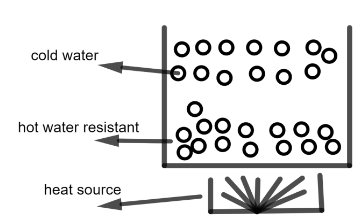
When a fluid is heated, its molecules close to the heat source absorb heat energy and rise upwards. The upward movement of molecules causes a fall in the pressure in that region. To equalize the pressure, colder molecules sink downwards and get heated in turn, thus rising again. This movement of particles sets up a current called conventional current.Conventional current plays an important role in weather phenomena, such as rainfall:
Answer
505.8k+ views
Hint: The transfer of heat from one place to another due to the movement of fluid is called convection heat transfer. The fluid in the hot surface has low density and low rinse due to expansion. A convection heat transfer is due to fluid. The fluid may be in gas or liquid state; both applications are in convection heat transfer.
Complete answer:

From the above diagram we can observe the convection heat transfer. We can observe from the diagram is, the cold water is upside down and water on the downwards is heated due to the heat source. The hot water resistance goes upwards and cold water comes downwards due to this process the hot water has low rinse and is less dense. The molecule of water particles in hot water resistance slowly goes upwards and molecules of cold water with high pressure slowly come downwards this process is called convectional heat transfer.
Note: As given data from question the water particles in the heat resistance slowly move towards upside and water particles in cold water slowly come downwards with pressure as shown in figure. Water in downwards is heated due to heat source from this the water gets heated and produces some convectional heat transfer.
Complete answer:

From the above diagram we can observe the convection heat transfer. We can observe from the diagram is, the cold water is upside down and water on the downwards is heated due to the heat source. The hot water resistance goes upwards and cold water comes downwards due to this process the hot water has low rinse and is less dense. The molecule of water particles in hot water resistance slowly goes upwards and molecules of cold water with high pressure slowly come downwards this process is called convectional heat transfer.
Note: As given data from question the water particles in the heat resistance slowly move towards upside and water particles in cold water slowly come downwards with pressure as shown in figure. Water in downwards is heated due to heat source from this the water gets heated and produces some convectional heat transfer.
Recently Updated Pages
Master Class 11 Economics: Engaging Questions & Answers for Success

Master Class 11 English: Engaging Questions & Answers for Success

Master Class 11 Social Science: Engaging Questions & Answers for Success

Master Class 11 Biology: Engaging Questions & Answers for Success

Class 11 Question and Answer - Your Ultimate Solutions Guide

Master Class 11 Business Studies: Engaging Questions & Answers for Success

Trending doubts
10 examples of friction in our daily life

One Metric ton is equal to kg A 10000 B 1000 C 100 class 11 physics CBSE

Difference Between Prokaryotic Cells and Eukaryotic Cells

1 Quintal is equal to a 110 kg b 10 kg c 100kg d 1000 class 11 physics CBSE

Explain zero factorial class 11 maths CBSE

What is a periderm How does periderm formation take class 11 biology CBSE




